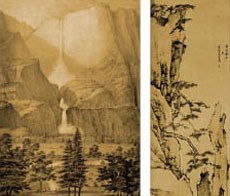
Yosemite's sister park arrangements provide a framework for collaboration with parks and protected areas that face similar challenges. Yosemite National Park and each respective sister park have an official arrangement, signed by both park superintendents or their equivalent, that is valid for a three to five-year term. Yosemite currently has nine formal sister park relationships with Huangshan and Jiuzhaigou National Parks in China, Torres del Paine National Park in Chile, Berchtesgaden National Park in Germany, Lake Hovsgol and Tengis-Shishged National Parks, Horidol-Saridag and Ulaan Taiga Strictly Protected Areas in Mongolia, Chitwan, Langtang, and Sagarmath National Parks in Nepal, Blue Mountains National Park in Australia, Wadi Rum National Park in Jordan, and most recently Cumbres de Monterrey National Park in Mexico. Although Yosemite was established earlier (in 1890) and is larger (747,956 acres) than some of its sister parks, it faces the same global challenges today as its sister parks do. Threats include carrying capacity and the effects of urban growth. Park boundaries protect parks from human impacts, but some negative factors, like air and water pollution, do not stop at the park border. Yosemite has a formal relationship with each of its parks to share resource management techniques, to preserve and increase natural biodiversity, to restore healthier habitats, and to encourage environmental education. Yosemite and some of its related sister parks have received recognition from UNESCO (the United Nations Education, Scientific and Cultural Organization) as World Heritage Sites or Biosphere Reserves. In 1984, Yosemite was designated a World Heritage Site. 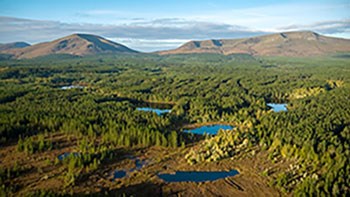
Wild Nephin National Park (Ireland)In November 2023, Yosemite National Park and Ireland’s Wild Nephin National Park agreed to become sister parks. Wild Nephin National Park is located in County Mayo in the west of Ireland and contains much of the Nephin Beg Mountains. Like Yosemite, Wild Nephin is predominately wilderness with significant wetlands, diverse flora and fauna, forests, fisheries, gateway communities, a variety of cultural resources, and dark night skies. By becoming sister parks, Yosemite and Wild Nephin agree to cooperate in the management of national parks and protected areas. Specific areas of cooperation include exchanges of information, educational activities, expertise, and staff. 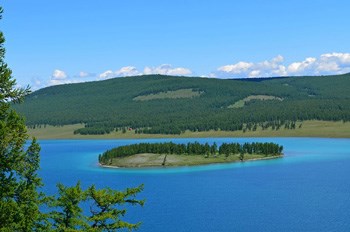
Mongolia Sister ParksLake Hovsgol, Tengis Shishged, Horidol-Saridag, Ulaan Taiga, and Yosemite share many similarities. These five parks are rooted in dramatic mountain ranges and support the headwater of pristine, important rivers that support diverse ecological communities, immense natural resources, and centuries of human history. These parks all protect threatened and endangered species including endemic sheep and fish. Each park has provided a home to native people for millennia and must protect important cultural resources and historic sites, as well as natural resources. The parks are also strong economic engines for their surrounding communities, but similarly face increased challenges from development, population growth, and climate change. Lake Hovsgol National ParkLake Hovsgol is one of the world's 17 ancient lakes and the fourth deepest lake in all of Asia. The "Mother Sea," as Mongolia's nomadic people call the lake, contains 70% of Mongolia's surface-water resources and 1% of the world's freshwater. Water entering the lake in the north exits in the south via the Eg River after 500 years. Lake Hovsgol is the only ancient lake in the world completely surrounded by permafrost. To preserve this important watershed, the Mongolian Government declared Lake Hovsgol as a protected area in 1986. Today the park encompasses 2.9 million acres. The lake is 90 miles long and 25 miles wide at the widest point. The tallest mountain in the park, Monkh Saridag is on the Russian border and is 11,453 feet above sea level. Rich in biodiversity, the lake is surrounded by mountain steppe and taiga forests which host the argali sheep, ibex, elk, reindeer, musk deer, brown bear, and lynx. Tengis-Shishged National ParkEstablished in 2011, Tengis-Shishged National park is named for the two rivers that flow from its mountains. The park encompasses 2,149,817 acres and is known for its resident population of reindeer herding nomadic families and the Hucho taimen, the world's largest trout. 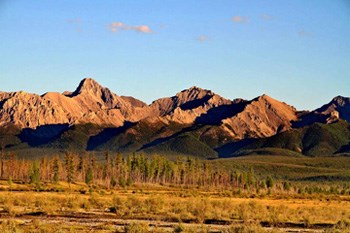
Horidol-Saridag Strictly Protected AreaAn area of the Horidal Saridag Mountains, immediately west of Lake Hovsgol was established as a Strictly Protected Area in 1997. The park, at 558,458 acres is a mountainous area that provides habitat for the northern Mongolia range of Argali sheep and Ibex. Ulaan Taiga Strictly Protected AreaConsidered on the few untouched areas in the world, the Ulaan Taiga is situated on the southewest side of the Darkhad Valley. The protected area was enlarged to encompass 1,074,661 acres and converted into a Strictly Protected Area in 2011. There are 300 small lakes in the taiga. 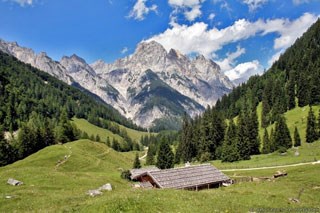
Berchtesgaden National Park (Germany)At the edge of the Northern calcareous Alps, the Berchtesgaden National Park pushes like a wedge towards Austria. Three deep valleys, highly dissimilar in character, and their massifs towering to 8,900 feet, mark the topography of the park’s high mountain range. Berchtesgaden National Park is best known for its magnificent high mountain vistas, fabled blue and green lakes, spectacular waterfalls, and its unique wildlife. It was declared a UNESCO Biosphere Reserve in 1990; the park joined the Man and Biosphere Conservation Network in 1990 and has also received IUCN Category II and ISO 14,001 accreditations. Berchtesgaden and Yosemite National Parks share similar scale management issues for research, inventory, and monitoring programs necessary to achieve success in preservation efforts. Both parks face many common threats, including air and water pollution, changes in ground and surface water hydrology, ecosystem fragmentation caused by past land uses and growing urban encroachment, and the adverse impacts of excessive visitation and illegal human activities. In 2014, Yosemite National Park and Berchtesgaden National Park agreed to formalize a sister park relationship in order to work cooperatively to exchange information, foster mutual friendship and to share our commitment to stewardship of protected areas management, interpretation, and conservation issues. View the official Berchtesgaden National Park website for more information. 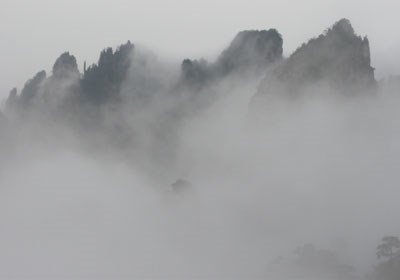
Huangshan National Park (China)On the other side of the world, Huangshan (Yellow Mountain) in eastern China’s Anhui province offers majestic waterfalls and world-famous pine trees amongst its granite cliffs. The Huangshan mountain range comprises many peaks above cloud level, including the 6,115-foot Lotus Peak. Amazingly, 60,000 stone steps, some of which might be 1,500 years old, are involved in ascending to the top of the range. Hot springs, retaining a constant water temperature of 107°F, can be found in the lush park that contains one-third of China's bryophytes and more than half of its ferns. Just as Yosemite's scenery has inspired artists like Thomas Ayres, Huangshan’s mountain cliffs and waterfalls have inspired artists like Hongren to use these peaks as a background in Chinese ink paintings for 1,000 years. Artistic expression generated at Huangshan has continued into the digital age--with movie maker James Cameron creating Avatar's floating mountains based on the Chinese park. In addition, more than 20,000 poems have been written in praise of the Huangshan region. 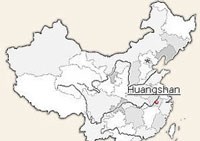
From www.chinahighlights.com Yosemite’s official sister-park relationship began with Huangshan in 2006. Although revered for centuries, this park area was set aside in 1982 by the State Council of the People’s Republic of China. Declared a World Heritage Site by UNESCO in 1990, the core boundary covers 38,054 acres with an additional 35,089 acres serving as a buffer zone. Human impacts can threaten existing protections. To compare Yosemite and Huangshan: Millions of people explore the parks each year, encountering long waits due to Yosemite's traffic jams and Huanghan’s busy cable cars. The sister-park relationship allows shared park approaches to working with gateway communities, regional and local economies, friends groups, and partner organizations. View more information about Huangshan National Park on the concessionaire's website. 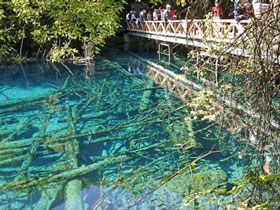
Jiuzhaigou National Park (China)In the Sichuan province of central China, thunderous waterfalls flow down cliffs in high alpine valleys backed by diverse forests of rhododendron, bamboo and pines in Jiuzhaigou’s 177,280 acres. Giant pandas and golden snub-nosed monkeys, both endangered, take refuge in the forests, amongst the limestone and karst cliffs and in the startling blue lakes. Temperatures remain cool year round, including summer, at elevations that rise from 6,500 feet to above 15,000 feet. Fall visitors brave chilly temperatures to view the temperate forest’s display of yellows, oranges and reds. 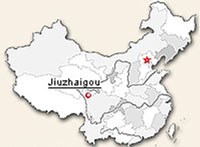
FROM WWW.CHINAHIGHLIGHTS.COM Prior to the area being a park, it was extensively logged until the late 1970s, when the Chinese government banned the activity there. The park’s establishment in 1978 led to its ecological restoration. Designated a UNESCO World Heritage Site in 1992 and a World Biosphere Reserve in 1997, the park has pursued a scientific mission, completing a 2004 baseline study of wildlife and its other resources. Becoming a sister park in 2006, Jiuzhaigou sent four rangers to Yosemite the following year for three months to observe how the United States promotes conservation with ongoing exchanges. (Read about their 2007 visit to Yosemite in an article in The Stockton Record.) Jiuzhaigou faces critical carrying capacity concerns. The Chinese park must keep 2 million annual visitors from trampling the fragile terrain and disturbing its shy wildlife. To combat this, Jiuzhaigou uses boardwalks—just as Yosemite does in the Valley. The park—so remote that most visitors must take a 10-hour-plus bus ride to access it—also limits its number of daily admissions through bar-coded admission tickets and a central command room connected via radio to shuttle buses to distribute visitors and prevent overcrowding at any particular location in the park. People are part of the Chinese park, too, with Tibetan natives living there for centuries. These Tibetans, who are no longer allowed to farm in their nine local Tibetan villages, have survived by taking park jobs, by working in tourist restaurants or by renting Tibetan costumes to visitors. Yosemite has a similar cultural story in which American Indians whose homelands became park lands created a means to participate in the new Euro-American economy by making crafts, such as baskets to sell, and by performing cultural demonstrations of food processing and ceremonial dancing to tourists. An Indian Village site, in Yosemite, has been re-created on the original village site where tribes from all over the region and beyond currently attend annual traditional cultural ceremonies important to keeping their culture alive. View more information about Jiuzhaigou National Park on its official website. 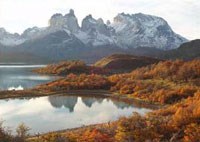
Photo by Ken Watson Torres del Paine National Park (Chile)Not many sites can claim to be among the most unspoiled places on Earth—but Torres del Paine is such a place. Located in Chilean Patagonia, the park includes the geologic Torres (Towers) del Paine, a portion of the Patagonian Icefield, and an endless number of lakes, glaciers, rivers and waterfalls within its 597,995 acres. The backdrop is the Paine massif, which is an eastern spur of the Andes, rising dramatically to 8,530 feet above the Patagonian steppe. Small valleys separate the spectacular granite spires, and clouds drape the mountain peaks in an ever-changing series of images. Hikers, and climbers, take in the sights several ways: a day trip to see the towers; a five-day walk on the popular “W” route; or an eight-day-plus trek on a circular path. 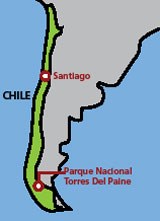
Established in 1959 as Parque Nacional de Turismo Lago Grey, Torres del Paine changed its name in 1970 and was designated a World Biosphere Reserve by UNESCO in 1978. Since 2000, the National Park Service and Chile’s Corporacion Nacional Forestal (CONAF) have cooperated in a number of conservation topics. On a broad U.S. tour in 2006, Torres del Paine park rangers visited Yosemite, impressed by the quality of services they experienced. In 2007, a sister-park partnership was signed, and Yosemite officials traveled to the Chilean park to develop a two-year action plan to encourage ways for the two parks to work together. In 2008, additional Yosemite staff traveled to Chile to continue the sharing of knowledge. Despite the fact that Yosemite is in North America while Torres del Paine is at the bottom of South America, the parks face similar management concerns including limited resources, development pressure, threatened or endangered species, trail erosion, and the impact of global climate change. Employees of both parks emphasize education, research, and inventory and monitoring programs. View the official Torres del Paine National Park website for more information.
Full List of Sister Parks
|
Last updated: November 13, 2023

